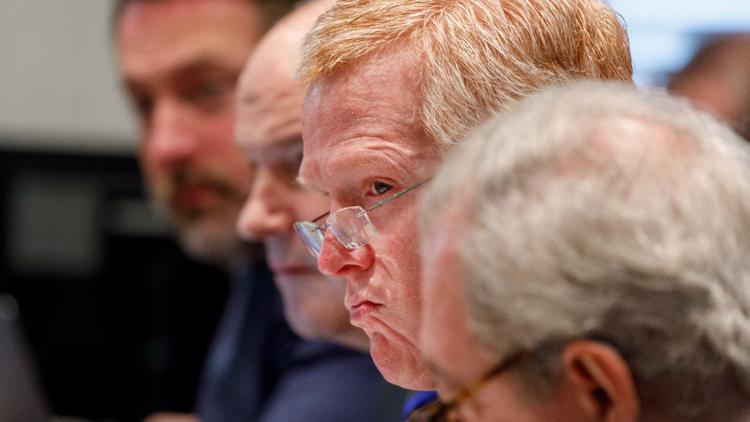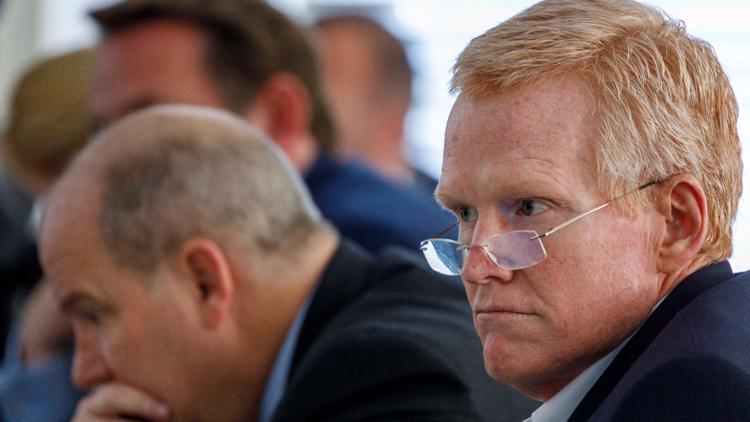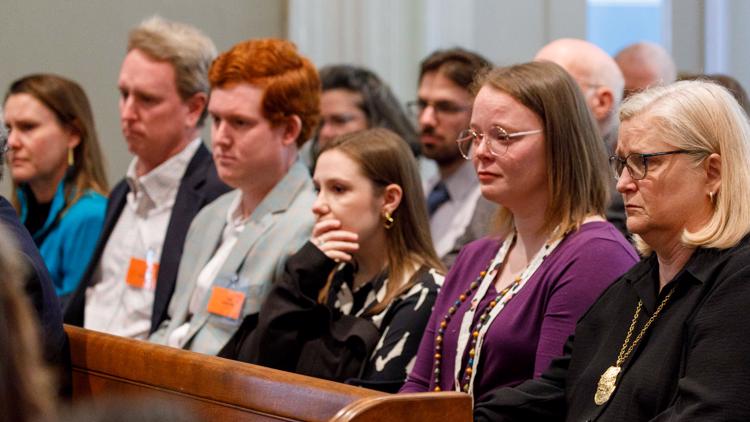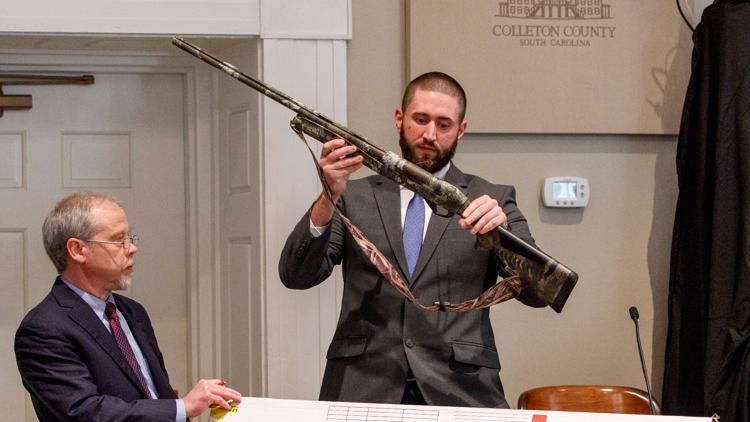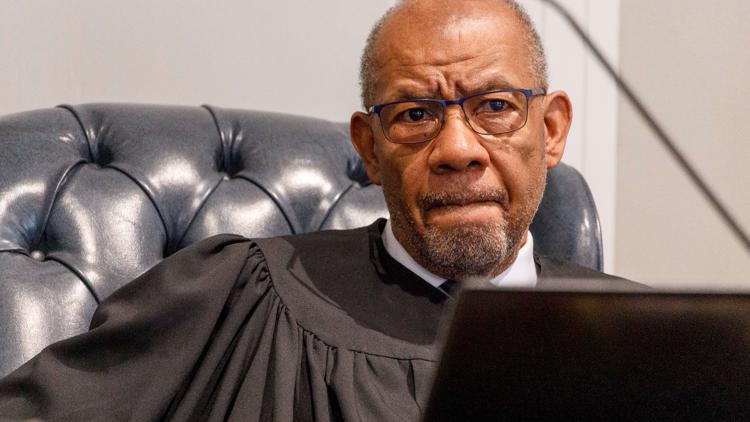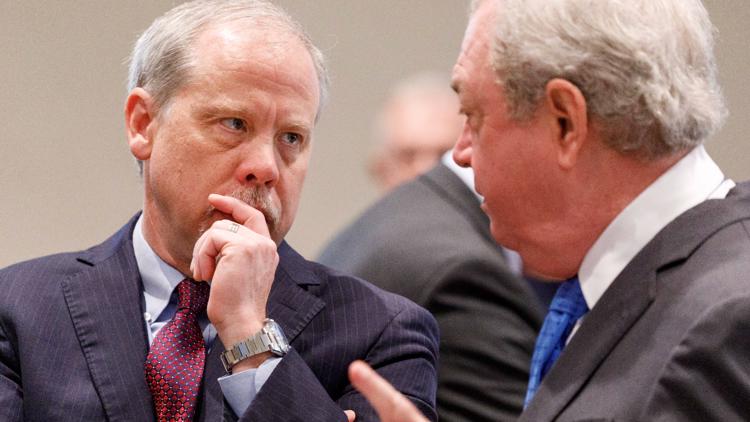COLUMBIA, S.C. — The first day of testimony in the Alex Murdaugh double murder trial began with first responders testifying what they saw when they arrived to the crime scene and the 911 call of Murdaugh asking for help.
The day also saw Murdaugh get emotional multiple times, visibly crying as he heard the calls he made and the graphic descriptions of what investigators found.
Murdaugh is charged with the June 2021 killings of his wife, Maggie Murdaugh, and his adult son, Paul Murdaugh, at their Moselle property at the Hampton and Colleton County line. Prosecutors and law enforcement say Paul was killed by two shotgun blasts, Maggie was shot five times with a 300 Blackout rifle. The defense maintains their client is innocent and say law enforcement rushed to judgment in pointing the finger at Alex Murdaugh.
After three days, the jury was finally seated in the case Wednesday, Jan. 25. The 12 member panel consists of eight women and four men, with six alternates as standbys. Both sides presented openings statements before the end of Wednesday, so prosecution witness testimony took up much of Thursday.
You can find updates throughout the day on this article. Live streaming coverage can be found here as well, on the WLTX+ streaming app on Amazon Fire and Roku TV, and on the News19 WLTX YouTube page.
Key Things to Know in the Alex Murdaugh trial
- Murdaugh was a prominent attorney whose family has a long history in the legal community
- He’s also facing other charges that he embezzled millions from his law firm and stole money from clients
- Investigation into this crime led to other probes into mysterious deaths associated with Murdaugh family
- Trial is expected to last around three weeks
Alex Murdaugh trial updates:
Sgt. Daniel Greene Testifies About Crime Scene
The first full day of testimony in the Alex Murdaugh murder trial began with the State calling Sgt. Daniel Greene, of the Colleton County Sheriff’s Office (CCSO), as the first witness. He was the first law enforcement responder at the scene on the Moselle property on June 7, 2021, answering a call for service where the dispatcher said, “the caller stated he found his wife and son shot.”
It is 45 minutes of Greene’s body cam footage that was shown to the court. In opening arguments on Wednesday, both the prosecutors and defense team said the footage would be “gruesome.” The footage was shown only to the jury, at the attorney’s tables, and to Greene in the witness chair so he could provide testimony as to what was happening on the video -- not the courtroom audience -- and it was not presented for broadcast.
Greene testified body cam footage is activated as soon as blue lights are activated in the patrol car, and is stopped when the wearer cuts it off. He said it took him about 20 minutes to respond to the scene, speeding with his blue lights activated.
Pulling into the long driveway to the dog kennel at Moselle, Greene said it was a typical June evening, rain off and on, hot and muggy.
As a first responder, Greene’s job is to secure the scene, preserve any evidence at the scene and gather basic information. When he arrived, Greene was not concerned that the perpetrator was still at the scene because the caller (Alex Murdaugh) “had been there for a while.”
PHOTOS: Alex Murdaugh murder trial - Day 4
He saw Alex Murdaugh at the kennel.
Paul was lying face down, close to a small shed to Greene’s left, with a large amount of blood and brain matter around his body. Maggie was found lying face down, with a large pool of blood around her body to Greene’s right in front of the feed shed.
Greene testified he checked Alex Murdaugh for weapons and that Alex Murdaugh’s first reaction was to first tell Greene about a boating accident involving Paul. Greene did not solicit the information.
Greene said Murdaugh did not appear to be crying but was upset. Murdaugh told Greene he left the scene, went to his residence to get a gun for his safety, and returned to the scene. The gun in question was a camouflaged shotgun, taken and secured by Greene and turned over to SLED when those agents arrived on scene.
Greene identifies the 12-gauge shot gun and it is shown to the jury. He confirms the chain of custody on the shotgun from himself to SLED agents.
Greene then confirms a CD disk holding his body cam footage from the scene, containing graphic images.
Prompted by lead prosecutor Creighton Waters, Greene describes the scene. Paul is lying face down to Greene’s left with a large pool of blood and an amount of water around his body. Maggie was laying face down in a pool of blood to Greene’s right.
You can hear Murdaugh say on the footage that he has a gun lying next to his vehicle. Then he tells Greene the story about Paul being involved in a boating accident and Paul had been getting threats, Alex thought were benign. Alex Murdaugh says on the video that is the reason for Paul’s murder.
Murdaugh says he will call up his phone to see the exact time of his arrival at Moselle. He asks about when EMS will arrive.
Murdaugh turns over his gun to Greene. It is loaded.
Greene secures the gun.
Greene continues to describe what he is seeing on the video. Murdaugh is on the phone, pacing. He asks multiple times about Paul and Maggie.
Waters asks Greene about Murdaugh’s appearance at that time and Greene testifies he did not observe blood on Alex Murdaugh at that time.
On the video, Greene asks Murdaugh when was the last time he spoke to Paul and Maggie. He says earlier this evening. He went to his mom’s house but rode around with Paul earlier for about two hours.
Murdaugh again asks about Paul and Maggie.
Greene tells the court that any reasonable person coming to the scene would conclude that Paul and Maggie were dead.
Greene says Murdaugh was upset, not panicky, and able to answer Greene’s questions. He was breathing heavy but did not ask for attention from EMS at the scene.
Greene asks CCSO Deputy William Pruitt to put up crime scene tape to preserve evidence, such as shell casings around the bodies. In the background, behind Murdaugh, tire tracks are visible. Greene thinks there are more tracks present than should be. Murdaugh says two are his from arriving and going to the house.
On the video, Greene approaches Murdaugh’s black Suburban.
After the initial interaction, Greene testifies Murdaugh spent most of his time at the property but away from the crime scene.
At the request of Greene, CCSO Deputies Pruitt and McDowell were marking locations of spent casings with pieces of crime scene tape.
Lt. Lonnie Nettles, Greene’s immediate supervisor arrives on scene. A crime scene log is started and Greene is notified that SLED is on the way.
Murdaugh’s brother arrived at Moselle and was allowed to talk to Alex. Alex was not in police custody at that time.
Greene and other investigators were trying to determine if there was a 300 Blackout underneath Paul’s body. The assumption is Paul may have shot Maggie and turned a shotgun on himself.
Greene was asked about Paul’s phone and said it was found on top of Paul’s body.
Greene continues to make sure the scene is secure until the body camera is cut off, after Greene gets an okay to do so by his supervisor.
CROSS EXAMINATION of GREENE
Lead defense attorney Dick Harpootlian says he tried to reach Greene about his testimony but could not connect with him. Yet, the prosecutor, Creighton Waters, talked to Greene three or four times.
Harpootlian asks Greene about the water he noticed around Paul’s body at the scene at the dog kennels. There is water inside and outside the pens and Harpootlian asks Greene if he had ever seen dog pens cleaned out.
Turning to the shotgun presented earlier, Harpootlian asks about the shells found inside the gun. Greene says he did not check the gun and agents from SLED discovered the ammunition. SLED found a 12-gauge shell and 16-gauge shell in the 12-gauge shotgun.
There were multiple 300 Blackout shell casings around Maggie’s body.
Under cross examination, Greene testifies he was first at the scene, Colleton County Fire and Rescue arrived later.
Harpootlian asks about tire tracks and footprints at the scene that may not have been properly preserved. Greene says it is not part of his job description to collect evidence.
Harpootlian replays Greene’s body cam footage, synched up with a transcript. On the tape, a fire rescue representative tells Greene there is a set of footprints behind the trailer. Fire and rescue says they attempted to preserve those footprints.
Alex Murdaugh is heard on the clip saying some of the tire tracks near the scene were not his.
Alex then indicated, unsolicited by Greene, that Paul’s death was related to the Mallory Beach boating accident.
Harpootlian asks Greene what did he do, other than put up yellow crime scene tape, to preserve the scene. Greene said that is all he did.
Harpootlian says there was no additional lighting (floodlignts, etc.) to light up the scene and law enforcement officers were walking through the area and shows images of Paul and Maggie taken from body cam footage at the crime scene. One of Paul’s feet is still in the feed room, his head is in a pool of blood, along with what might be portions of his brain. Greene testifies the injuries to Paul and Maggie were catastrophic.
Harpootlian said the feed room was part of the crime scene and must be kept as pristine as possible. Greene testifies there was no reason for him to enter the feed room, unless there was a reason – such as assisting other responders -- for him to be there.
Harpootlian said that it is imperative to preserve the scene – cordon it off, take photos, not enter the area until SLED crime scene unit arrives. Greene says he was in charge of the deputies directly under his command, not any other law enforcement personnel.
Harpootlian shows Greene a photo of Maggie taken at the crime scene and asks Greene to identify her. Harpootlian asks wasn’t it natural for Alex Murdaugh to be concerned about Maggie, whether she would still be alive or not. Greene testifies it is natural.
Greene testifies that he did not know who determined the shots fired at Maggie came from a 300 Blackout.
In another portion of the body cam video, CCSO Deputies Chad McDowell and William Pruitt are shown standing inside the feed room.
Harpootlian asks if McDowell and Pruitt should have been in the room without protective gear (on their feet) in order to not contaminate the crime scene. Greene says it is not standard practice for CCSO deputies.
Greene does not recall bloody footprints being in the feed room.
Harpootlian asks if there were bloody footprints found in the feed room, could the footprints come from law enforcement at the scene? Greene says it is possible.
Harpootlian says evidence the scene that could incriminate or clear someone was contaminated in this case because of the lack of preservation. “If someone had come in and out of the driveway at Moselle, the evidence may have been obliterated by law enforcement,” he asks. Greene says yes, it is possible.
Waters then returns and redirects Greene. It is Greene's testimony he and CCSO officers responding did everything they could to secure the scene; it not his job, eh says, to do crime scene investigation work.
About the 300 Blackout casings (what is left after the projectile comes out of the weapon), there were multiple casings around Maggie’s body.
The tire tracks behind Alex Murdaugh’s vehicle were impressions in wet grass, not in dirt surrounding the area.
Greene asks Alex on the body cam footage if Murdaugh came in and out of the area where the tracks were noticed, and Murdaugh replies two of the tracks were his.
Greene testifies he did not know much about the boat incident involving Mallory Beach, and that Alex brought up the boat case unsolicited. Alex Murdauh can ge heard on the body cam footage that Paul had been threatened and punched because of his involvement.
Harpootlian said Greene was asked about the dewy tracks. Greene believes the tracks would still be there when SLED agents arrived and Greene did not point them out to investigators arriving later at the scene.
Deputy Chad McDowell
The second witness to take the stand is Colleton County Sheriff's Office Corporal Chad McDowell. McDowell is a road patrol officer and K9 handler.
At the time of the murders, McDowell was a deputy, working patrol on the night shift. He responded to the call of service at the Moselle property. When he arrived at the scene, McDowell testifies, Greene and a fire rescue unit were already at the kennels and all responding other vehicles were staged (stopped) at the top of the driveway.
McDowell testifies that arriving at the scene, he witnessed Greene interviewing Alex Murdaugh and McDowell returned to his vehicle.
Body cam footage from McDowell shown to the court has McDowell as he exits his vehicle, with the kennels are on his left and food shed on the right.
As road patrol officers, McDowell testifies, CCSO deputies' first priority is to preserve the scene as best as possible before turning the scene over to investigative team, and make sure there is no active threat to responding personnel.
McDowell's body cam video captures Greene asking fire and rescue to not disturb the scene or cover the bodies, because SLED is on the way. Fire and rescue responder says they were covering the bodies as the family was present.
McDowell heard on the video asking for tape to mark casings near Maggie’s body and telling fellow deputy William Pruitt to be careful not to disturb anything. McDowell personally owns a 300 Blackout and recognized the spent casings near Maggie's body.
Also on the video, McDowell can be heard to say “why are there so many shell casings, but only one gunshot to the back of the head?”
He walks the scene, pointing out blood and more 300 Blackout casings to be marked. McDowell testifies he was marking the location of the casings so they would not be disturbed, but, again, it is not his job to collect the evidence.
McDowell was asked about why he went into the feed room. McDowell testifies he turned on his light to see what he was doing before entering the scene. He says if he had noticed bloody footprints or anything else, he would have used caution before entering.
Paul’s phone is found outside his clothing on his rear end.
McDowell’s body cam footage records Greene saying Alex Murdaugh told him he had checked Paul’s body before calling 911 and Greene did not ask about the phone at the time.
McDowell testifies Paul’s body was found with his hands beneath his body.
CROSS EXAMINATION of McDOWELL
Harpootlian asks McDowell who was his supervisor when he arrived at the scene. McDowell says Greene was his supervisor and he was there to secure the scene for investigators.
McDowell said he was in the feed shed assisting lifting the sheet off Paul’s body for investigators looking for another weapon. He testifies that to his knowledge he did his best not to disturb the crime scene.
McDowell says in order to find the casings and blood, he used his flashlight.
Harpootlian asked "Why search for shell casings at that time?" McDowell testified he took the initiative to look for casings and -- to the best of his knowledge -- did not disturb the scene. McDowell said he felt the urgency to mark evidence because there were multiple agencies responding and he did not want evidence to be lost or disturbed.
McDowell testified he has basic training for crime scene collection and he did not do a crime scene sketch.
Harpootlian asks, could McDowell have rendered aid to Paul of Maggie? No, McDowell responds.
Harpootlian replays a portion of the body cam footage showing McDowell approaching the dog pens and a neatly coiled hose next to the pens. Alex Murdaugh is seen in a t-shirt and shorts, no visible blood on his clothing.
REDIRECT
McDowell reiterated in his testimony he is a first responder. He makes sure there is no threat to other first responders. His training is to secure the area. His job is not to collect evidence as an investigator but to mark it for the investigative team.
Alex Murdaugh was not treated as a suspect at the time.
Court then broke for lunch. The witness list contains more first responders from the Colleton County Sheriff's Office (CCSO), and the Hampton County and Colleton County dispatch offices.
Thursday afternoon session
Returning from lunch, court resumed at 2:30 p.m. with more first responder testimony. Scheduled witnesses include Tinish Bryson-Smith from Hampton County Dispatch, Angela Stallings of the Colleton County Dispatch, Fire Chief Barry McRoy at Colleton County Fire and Rescue, and Captain Jason Walker Chapman with the Colleton County Sheriff’s Office (CCSO).
Tinish Bryson-Smith
Prosecutors began the afternoon session calling Tinish Bryson-Smith from Hampton County Dispatch to the stand. Bryson-Smith has worked for Emergency Services/911 for 15 years. She testifies all 911 calls are recorded and stored, along with recordings from responding officers. At times, the Public Safety Answering System picks up calls originating in Colleton County and routes the call to Hampton County (and vice versa).
Hampton County Dispatch was the first ES/911 to receive Alex Murdaugh’s 911 call (originating from the Moselle Property in Colleton County) on June 7, 2021.
Angela Stallings
Angela Stallings , of Colleton County Dispatch, worked at CCSO for 15 years as captain over administrative services, 911 center, and records. All 911 calls are recorded and stored.
Stallings says it’s normal for calls received at Hampton Dispatch to be routed to Colleton County Dispatch. She testifies the call from Hampton County transferring Alex Murdaugh to Colleton County Dispatch came in at 10:07:09 p.m. on June 7, 2021.
On the call, Murdaugh can be heard identifying himself and saying his wife and son -- Maggie and Paul --are not breathing, and that Paul was shot in the head, “really bad.”
When asked by the dispatcher, Murdaugh says he last heard from Maggie about two hours ago, in person. He is sure they are not breathing.
He tells the dispatcher he is going to his house “to get a gun just in case.”
The dispatch operator asks Alex to not have a gun with him when law enforcement arrives.
Murdaugh says “Paul has been threatened for months and months and months,” and that Paul would know who did this.
Still on the line with the dispatcher, Murdaugh says “OK, I’m heading back down there” after retrieving a gun from his house.
The dispatcher tells Murdaugh not to touch the bodies or move anything that would disturb evidence. Murdaugh said he already touched the bodies to see if they were alive.
Murdaugh is asked if Paul made any reports to law enforcement about the threats, and Alex says Paul did report the threats.
As the call is played for the court, Alex Murdaugh rocks back and forth in his seat at the defense table.
Fire Chief Barry McRoy
Prosecutors next call Fire Chief Barry McRoy, with Colleton County Fire and Rescue, one of the first responders at the scene on June 7. McRoy has worked with CCFR for 29 years and has been a paramedic since 1981.
McRoy says standard operating procedure for someone who has been shot is for Emergency Services to go in after law enforcement has cleared the scene and then treat the patient, try to stop any bleeding, and transport patients to the closest trauma center.
McRoy testifies he arrived on the scene first at Moselle and was told to wait for law enforcement before entering the property. Colleton County Sheriff’s Deputy Sgt. Daniel Greene arrived shortly after and McRoy said he followed Greebe down the driveway to the crime scene at the kennels.
McRoy identifies photos of the crime scene. He testifies Greene came to the kennels first and McRoy used his headlights to see the scene. There was a young male with a wound to the head near the kennel and a female with wounds near a lean-to building, and Alex Murdaugh a little further away on a cell phone. McRoy covered the bodies since Alex Murdaugh was present.
McRoy describes Paul laying face down with severe injuries, with what McRoy says was “brain matter near his feet.”
Maggie Murdaugh had a wound to the head, “you could see inside.”
McRoy testifies he did not check the bodies because, he says, both had “injuries incompatible with life.”
ON CROSS EXAMINATION
Harpootlian asked McRoy of Alex Murdaugh’s appearance and McRoy testifies Murdaugh, who McRoy knew socially, seemed “really upset.”
Harpootlian asked about tire tracks in the grass. McRoy testified he drove into the property off Moselle Road behind Greene and the deputy parked between the buildings and McRoy activated his bright lights to light the scene.
McRoy said he noticed the tire tracks about 30 feet away and brought it to the attention to one of the CCSO deputies, he does not recall who he spoke to. McRoy says deputies did not put yellow tape around the tire tracks and there were civilian vehicles entering the scene.
McRoy testifies he observed Paul’s body without going into the shed, and he and others backed off the scene when deputies began putting up yellow tape.
Cpt. Jason Walker Chapman
The next witness called was Jason Walker Chapman. Currently a captain with CCSO, has worked for CCSO in various positions for 26 years. Chapman oversees tactical team and gives expert testimony in general police procedures.
Chapman’s role was supervising investigations, including homicides in 2021. He testified he heard the 911 call come in and responded. He was familiar with the Murdaugh family and was told by the CCSO Sheriff that if it indeed was the Murdaugh family, SLED would be contacted because there might be a conflict of interest with CCSO investigating the scene.
Chapman testified CCSO would have obtained a search warrant for the joint investigation with SLED.
Chapman testified he observed patrol units were already present when he arrived and reminded units to preserve the crime scene. CCSO Sheriff requested a tent to cover the bodies because there was a forecasted rain event approaching. Knowing the SLED crime scene unit was enroute, Chapman testified he turned a deputy around from the scene to get the paperwork started for the search warrant.
Rain was coming, so a tent was placed over Maggie’s body to preserve evidence. Paul’s body was under a small ledge.
Arriving at the scene, Chapman said the inner perimeter scene where the bodies were, no one knew if there was an active shooter, a murder/suicide, or a suspect/shooter in the woods. He testifies the inner perimeter area was being secured, but not the outer perimeter.
Chapman said in his opinion both Maggie and Paul were deceased and what he saw, the victims were beyond assistance.
Chapman testifies besides the two victims and responders, Alex Murdaugh was the only person present at the time of Chapman’s arrival.
There was no time for CCSO to photograph evidence before SLED arrived.
A sheet was placed over both victims before Chapman’s arrival. Chapman had deputies lift the sheet over Paul to check for a firearm, but they did not find one. They did not move his body and noted his arms were underneath his body. There were no firearms found near Maggie’s body.
The area in front of the feed room and the kennels were wet, not consistent with the weather of the day. Paul was saturated with blood and tissue and water from the pooled water at the kennels, as if he fell in the water and it seeped into his clothing.
Chapman testifies he ordered McDowell into the feed room to lift the sheet straight up off Paul’s body rather than pull it off so that evidence might be preserved.
Chapman testifies Paul’s feet were toward the feed room, majority of the head is gone, some or most of the brain laying opposite from where Chapman was standing, and a smart phone propped up on top of his backside. Paul’s hands are underneath him. Chapman stood by as another officer bagged the phone and placed it in evidence, Chapman does not recall any blood or water on the phone, and it did not leave a blood or water stain when lifted off the body.
Chapman testifies he is familiar with 300 Blackout. At the time, Chapman testifies this was only the second time a 300 Blackout was used in a homicide.
Chapman testifies he talked to Alex Murdaugh on two occasions during that night and had a chance to observe him. He says some of the physical observations of Murdaugh: he was breathing hard, sweating but not crying, and he seemed to be in torment. Chapman says Alex’s clothing was not dirty or bloody, nor were his hands.
With the scene being fluid, Chapman testifies, he asked for the recording of the 911 call to listen to the call, listen for background noises, what was said, and compare it to evidence or statements at the scene.
On the 911 call Murdaugh, says he touched both bodies, but Chapman testifies he did not see blood on Alex Murdaugh. Chapman says common areas to check for a pulse would be neck and wrist. Paul’s hands were beneath the body. Paul was laying face down and Chapman says it would have been difficult to test for a pulse on Paul without getting blood on his clothing or hands.
Listening to the 911 call, knowing Murdaugh retrieved a gun, Chapman thought it odd that Murdaugh would cut off the 911 call in order to call his family (brother). By his own admission, Alex Murdaugh left the scene, went to the house to get a gun, and returned to the scene. In Chapman’s opinion, that would also make the house at Moselle part of the crime scene.
Chapman testifies Alex Murdaugh shifted his demeanor slightly during certain lines of questioning and testing for gunshot residue. Chapman said SLED usually performs the gunshot residue test but CCSO performed the test that night because there is a 6-hour limit for retrieval of a sample of an individual.
Chapman testifies Alex was more fixated on the body of his son rather than his wife.
Regarding the tire tracks: there is a grassy area behind the buildings as opposed to the dirt and gravel between the kennel and feed building. Murdaugh’s Suburban was parked in the grass and said there should be two sets – when he arrived and when he came back. There seemed to be another set of tracks near Maggie’s body. CCSO tried to follow the tracks and began to wonder how Maggie and Paul arrived at the kennels since it was a bit of a walk between the kennels and the house. There were no other vehicles at the scene, other than Alex’s and law enforcement vehicles.
Chapman identifies two drone videos taken the morning after the murders that show the Moselle property, the entrances and exits, main house and outbuildings (dog kennels, an old airplane hangar used as a storage/feed room, and a building used to dress game), and the investigators on the scene. The footage was taken for investigative purposes to easily locate the positions of Maggie and Paul Murdaugh’s bodies, Alex Murdaugh’s vehicle, a black truck found on the property (later identified as a farm truck and did not match the tracks found at the kennels), the location of the tire tracks and footprints found on the night of the murders, and the crime scene units on the scene.
Chapman mentions footprints found in the dirt on the side of the hangar that appeared to be from a sandal or flip-flop and were located to the left of the feed room. Investigators made the decision to walk a line off the side of the footprints, following them in a path along the edge of the hangar structure that appeared to go from one end of the building and back. There was only one set of footprints, Chapman said, and they went from one side of the hangar, under the overhang, and back again. The footprints/impressions were of a smooth-bottomed shoe.
Chapman identifies a photo from the crime scene, handed to him by assistant prosecutor David Fernandez, showing the lower part of Maggie’s body and the shoes she was found wearing. Chapman testifies the footwear seems close to the size, shape, and design of the footprints found near the hangar at the crime scene.
He testifies at one point, CCSO issued a BOLO (be on the lookout) for a white Ford F-250 used by Paul as possibly stolen or taken from the scene. The truck was located around 10:30 the following morning, just inside Hampton County.
Fernandez asks Chapman about Alex Murdaugh’s demeanor. Chapman said he noticed Alex’s demeanor tensed and changed and that Alex was watching investigators when they moved toward the tire tracks, and relaxed a bit when they moved away from the area where the tire tracks were located.
ON CROSS
Harpootlian asks Chapman if Alex’s change in demeanor could have been related to the possibility of discovering evidence of a shooter or shooters. Chapman answers, yes, that is possible.
There were two other sets of tracks, one running through the dirt that matched someone who took care of the dogs.
Harpootlian: in earlier testimony, Colleton County Fire Chief McRoy said he had found tire tracks going into the Moselle property, did he inform you of that? No, he did not inform me. I was not aware of any extension of what may be the crime scene.
Chapman testifies if he had known, he would have taken measures to preserve the tracks for evidence.
Harpootlian asks if Chapman was aware Alex came to the scene at the kennels, made the 911 call, drove to the house to get a gun, and returned to the kennels. Chapman says he was aware because he had listened to the recording of the 911 call.
When asked by Harpootlian, Chapman says someone in the house could not have seen the position of Paul or Maggie at the kennels due to the time of night and trees and grapevines between the house and kennels.
Harpootlian asks if Paul could have driven the black truck earlier in the day and Chapman answers it is possible.
Harpootlian asks about the footprints found at the scene. Chapman testifies the only footprints he and Detective Laura Rutland found belong to the flip-flops. Chapman testified he relayed the information to the SLED crime scene unit, and it was up to SLED to photograph and document the scene. Harpootlian said there is an impression of a footprint on top of the flip-flop impression and asks if it belonged to Chapman or Rutland. Chapman said no.
Harpootlian asked if that walking through the crime scene is best practice and Chapman said he would not be happy if one of his deputies walked across the footprints.
Harpootlian asked about the water pooling around Paul’s body. Could it have come from water buckets for the dogs. Chapman said it is possible.
There was what seemed to be a shoe impression on the back of Maggie’s leg and Harpootlian asked Chapman if he knew of any analysis done on the print. Chapman did not know of the footprint or any analysis that might have been done.
Harpootlian asked if Chapman had made any assumption of a suspect and referred him to a statement put out by CCSO the morning after the murders -- and published in the Post & Courier newspaper on June 8, 2021 -- stating that “there was no danger to the public.”
Chapman testifies that he doesn’t believe the statement was issued by CCSO because CCSO was not the primary investigative agency. Chapman says he had no complete information, the case went to SLED and CCSO became a support agency for SLED.
Chapman did say CCSO obtained the search warrant for the entire 1,700-acre Moselle property and turned it over to the SLED crime scene unit and SLED executed the warrant. Chapman testifies CCSO did not go into the main house as part of the investigation under his direction.
ON REDIRECT
Fernandez asks Chapman could tell where the footprints started, where they went and where they ended up.
Chapman says the impressions started on the grassy side, went around the hangar and back again.



